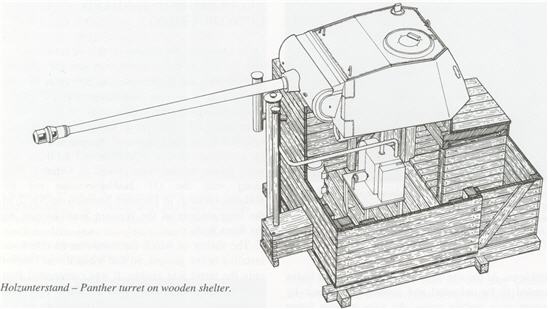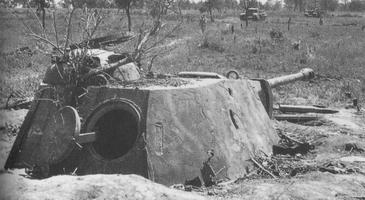Hello everyone,
if you follow FTR for a while, you might remember that at one point, there was a piece of information leaked about the new Stronkhold mode having bot-controlled turrets as defensive buildings. As I wrote before, the use of tank turrets as bunkers is not a complete Wargaming invention – and today, we’re going to have a look at one specific installation, the Panther Ostwallturm mount.
Panther turrets were converted into bunkers ever since late 1943. Some were serial Panther tank turrets, but most were specifically modified for the role of a bunker turret. The commander’s copula was replaced by a hatch and the roof of the turret was reinforced to 40mm (earlier 16mm) to prevent the turret from being knocked out easily by artillery fire. According to German specifications, the roof was supposed to withstand the impact of HE shells up to 150mm.
The first batch of 112 turret parts sets was made by Dortmund Hoerder Hüttenverein and it was finished by February 1944. Second batch of 155 turret parts sets was produced by Ruhrstahl and the production run finished in August 1944. The final assembly took place at Demag-Falkansee, producing 98 assembled Panther Ostwallturm sets until May 1944 with the production going on from that point with the speed of 15 turrets per month.
There were two foundations used for the turret – a steel welded box called Pantherturm I (Stahluntersatz) and a massive concrete foundation called Pantherturm III (Betonsockel). Additionally, there was also a third plan from 1944 to put the Pather turret on a wooden bunker. The turret itself consisted of two parts – the upper part (960mm tall) equalled roughly the combat compartment of a tank. The turret was mounted on a roof, that was 100mm thick. The sides were 80mm thick and the ammunition was stored around the turret basket. This upper box was assembled by Krauss-Maffei in Munich. The lower part of the box was a crew compartment with heating and an electrical generator, powered by a DKW engine. It had a large door (protected by a trench/tunnel) and there was also a small escape hatch. The sides were 70mm thick and the floor was 40mm thick – the crew compartment box did not have a roof, it was covered by the combat compartment box.
Until 26.3.1945, 268 Panther turret sets were built and despite the set’s name (“East wall”), majority of them was used on the western front (Westwall and Atlantic Wall) and in Italy, several dozen were used in the East as well. The last ones were used during the battle of Berlin. These turrets were a very effective weapon – they were small, hard to spot and very tough (they were resistant to Allied 6pdr and 75mm guns). Of course, in the end, it was just a bunker and it was possible to flank it and destroy it by firing in its side armor.
Source:
Spielberger – Panther und seine Abarten
pavel70slama.blog.cz/1211/panther-ostwallturm
www.historyofwar.org/articles/weapons_panther_ostwallturm.html




I wonder how effective they would have been if the turret could turn around…
I am pretty sure they could, however not being able to cover more than a single direction at any given time it is easy for ground forces to split up and flank it…
Ah, ok, I see :)
there is no indication of their being powered, hand cranking would be slow…
“an electrical generator, powered by a DKW engine”
Still the same, its a set piece and once one portion of the line is breached then the rest will fall one by one.
they are not there to hold the entire enemy army, but either to delay them long enough till the mobile army gets there or to make them choose a different route to avoid them… learn some basics
Were those constructions successful in combat?
were tiger turrets also used as bunkers? or even tiger II turrets? would be interesting….
btw nice article :)
the Porsche Tiger I turrets were shipped off for use as bunkers.
really? do you maybe have a picture of that?
http://i622.photobucket.com/albums/tt310/vanhall-panzers/Tigers/231.jpg
You mean these? These weren’t real bunker turrets, they were for training new Tiger tank gunners. :=)
wow thats some pretty interesting stuff there! thx mate :)
It is so curious to read this when we know, that there were plans to mount PzKpfw IV turrets on Panthers hulls.
Btw after fall of socialism in Czechoslovakia there was some ideas to reactivate pre-war monumental border fortification system by mounting of the turrets from T-54/55, thousands of which has been mustered out from the service in the late 80s.
Btw there was also many captured IS-3 turrets on the israeli Bar-Lev line in 1973.
Hey, check this out
http://en.wikipedia.org/wiki/100_56_TK
It’s basicly T-54/55 turret without stabilizers, put on top of a concrete bunker, meant to stand against naval offensive. These things aren’t in active service anymore though…
>40mm (…) roof was supposed to withstand the impact of HE shells up to 150mm
Maybe if the shell landed 50 meters or further away. The blast from a near hit of a 150mm shell would rip the turret our of the emplacement.
He only mentioned the “roof.”
Didn’t mention rest of the turret.
The word is still ‘CUPOLA’.
Interesting info!
Did some of those survived to this day (as monuments)?
This is what you’re looking for:
http://ftr.wot-news.com/2014/06/10/tank-turrets-as-bunkers-wargaming-fantasy/
This I saw, off course. I meant the Panther one.
Thx anyway.
There is a reconstructed one (using original turret) in Świnoujście, Poland.
http://odkrywca.pl/forum_pics/picsforum26/w5.jpg
Just as a note the Demag facility was in Falkensee not Falkansee.
[And as another note, I find it deeply disturbing that there's no trace of that KZ Sachsenhausen "Außenstelle" still visible...]
Funny, in the 50′s we had a similar defense line along the river IJssel. Loads of Allied tanks were dumped here, and we used turrets of those.
http://goo.gl/maps/emWEa
Sherman Firefly turret there.
My grandfather talked about running into these in southern italy in mid 1943, and how the easiest thing to do was call in 25pdr or 105s on them to take them out.
Not only were the Panther Turrets used as fixed gun positions
the Aft turret from the German battleship Gneisenau, was placed as a fixed gun position in the Austrått Fort in Norway where it remains to this day ( visible if you simply google map search the fort )
http://www.forsvarsbygg.no/Global/NFV/Austr%C3%A5tt/Austr%C3%A5tt1.jpg
http://files.reiseguiden.no/files/m620/austratt-fort-orlandet-sor-trondelag-norge-842684.jpg
These turrets were used extensively by the germans in WWII to act as a defensive line, they were fully self supporting and electrically powered in order to both light the interior and drive the turret in rotation. they were used to great effect on Canadian armour in Italy.
http://www.ospreypublishing.com/articles/world_war_2/German_use_of_tank_turrents/
They were also used in the defence at D-Day in Normandy:
Renault Turrets:
http://www.d-daytoursnormandy.com/wp-content/uploads/2014/01/Renault-Tank-Turret-on-Omaha-Beach-Emplacement.jpg
http://militaryanalysis.blogspot.co.uk/2014/02/tobruk-fortification.html
Early German Turret:
http://en.wikipedia.org/wiki/Omaha_Beach#mediaviewer/File:German_turret_at_Omaha_Beach.jpg
Ultimately they were used in desperation to try to stem the tide of the Allies advance.